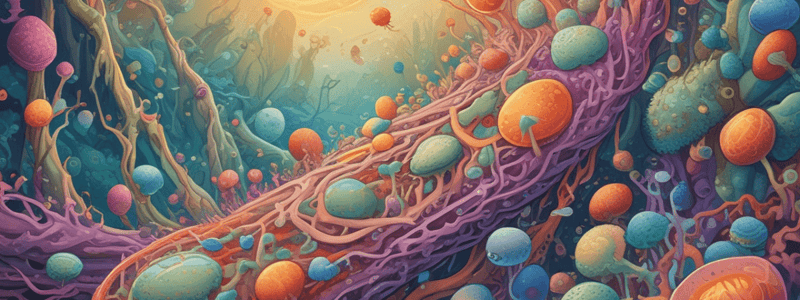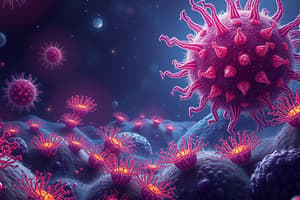Podcast
Questions and Answers
What is the function of the internal membrane system in a chloroplast?
What is the function of the internal membrane system in a chloroplast?
- To capture light for photosynthesis (correct)
- To segregate harmful products from the rest of the cell
- To form the cytoskeleton
- To separate the cell from its environment
What is the purpose of the cytoskeleton?
What is the purpose of the cytoskeleton?
- To segregate harmful products from the rest of the cell
- To capture light for photosynthesis
- To separate the cell from its environment
- To provide shape and fluidity to the cell (correct)
What is the name of the membrane-bound structure that contains the genetic material in a cell?
What is the name of the membrane-bound structure that contains the genetic material in a cell?
- Mitochondria
- Nucleus (correct)
- Lysosomes
- Golgi apparatus
What is the function of the endoplasmic reticulum (ER)?
What is the function of the endoplasmic reticulum (ER)?
What is the primary function of mitochondria in a cell?
What is the primary function of mitochondria in a cell?
What is a characteristic of eukaryotic cells?
What is a characteristic of eukaryotic cells?
What is the function of pseudopodia in an Amoeba?
What is the function of pseudopodia in an Amoeba?
What is the main function of chloroplasts in a cell?
What is the main function of chloroplasts in a cell?
What is the characteristic feature of plant cells?
What is the characteristic feature of plant cells?
What is the number of cells in a Pandorina colony?
What is the number of cells in a Pandorina colony?
What is the function of starch granules in a cell?
What is the function of starch granules in a cell?
What is the difference between plant and animal cells?
What is the difference between plant and animal cells?
What is the main function of mitochondria in a cell?
What is the main function of mitochondria in a cell?
What is the result of the absence of a lysosomal enzyme in Tay-Sachs disease?
What is the result of the absence of a lysosomal enzyme in Tay-Sachs disease?
What is the origin of mitochondrial DNA?
What is the origin of mitochondrial DNA?
What are the three main components of the cytoskeleton?
What are the three main components of the cytoskeleton?
What is a common symptom of mitochondrial diseases?
What is a common symptom of mitochondrial diseases?
What is the purpose of the cytoskeleton in a cell?
What is the purpose of the cytoskeleton in a cell?
What is the primary function of dystrophin in skeletal muscle?
What is the primary function of dystrophin in skeletal muscle?
What is the average diameter of a typical bacterial cell?
What is the average diameter of a typical bacterial cell?
What is the primary reason why cell size is limited?
What is the primary reason why cell size is limited?
What is the main function of the plasma membrane?
What is the main function of the plasma membrane?
What type of ions are repelled by the hydrophobic region of the plasma membrane?
What type of ions are repelled by the hydrophobic region of the plasma membrane?
In eukaryotic cells, what is the additional site of transport besides the plasma membrane?
In eukaryotic cells, what is the additional site of transport besides the plasma membrane?
What is the primary function of rough ER in a pancreatic cell?
What is the primary function of rough ER in a pancreatic cell?
Which type of stem cells are totipotent?
Which type of stem cells are totipotent?
What is the characteristic feature of a sperm cell?
What is the characteristic feature of a sperm cell?
What is the role of a smooth muscle cell?
What is the role of a smooth muscle cell?
What is a characteristic of embryonic stem cells?
What is a characteristic of embryonic stem cells?
What is the term for the process of cell death?
What is the term for the process of cell death?
Flashcards are hidden until you start studying
Study Notes
Cell Structure and Function
- Cells are the smallest living units capable of growth, movement, reproduction, and life span varies from a few minutes to years.
- All cells have an outer membrane that separates the cell from its environment and other cells.
- Within the outer membrane, there is a solution of proteins, electrolytes, and carbohydrates called cytosol, which is divided into specialist compartments known as organelles by inner membrane systems.
Organelles
- Organelles are a hallmark of eukaryotic cells and concentrate enzymatic reactions, separate competing metabolic processes, segregate harmful products from the rest of the cell, and secrete substances.
- Examples of organelles include the nucleus, mitochondria, Golgi apparatus, lysosomes, centrioles, vesicles, and peroxisomes.
Mitochondria
- Mitochondria are the "powerhouse of the cell" and are more abundant in cells with a high metabolic rate.
- Mitochondria have many internal folds and are rich in enzyme systems vital to energy production.
- Mitochondrial DNA codes for some of the proteins it needs, but not all, and comes from the mother.
Cellular Organelles and Their Roles
- The nucleus is the control center of the cell and contains genetic information.
- The endoplasmic reticulum (ER) is a network of interconnecting channels that is studded with ribosomes.
- Lysosomes contain digestive enzymes and break down worn-out cellular components.
- Golgi apparatus is involved in protein synthesis and secretion.
- Centriolesare involved in the formation of cilia, flagella, and spindle fibers.
- Vesicles are involved in cell signaling and transport.
- Peroxisomes are involved in the breakdown of fatty acids and amino acids.
Cell Types
- There are different types of cells, including eukaryotic and prokaryotic cells, plant and animal cells, and stem cells.
- Eukaryotic cells have an outer membrane and internal membrane systems, while prokaryotic cells lack internal membrane systems.
- Plant cells have chloroplasts and large vacuoles, while animal cells have more mitochondria.
- Stem cells are capable of differentiating into different cell types and are found in embryos, bone marrow, and other tissues.
Cell Size and Shape
- Cell size varies from 3-5 μm in diameter for bacteria to 50 μm in diameter for most eukaryotic cells.
- Cell size affects the uptake and excretion of substances, and surface area increases are not equal to volume increases.
- Cells can increase their surface area by dividing, making themselves long and skinny, or having extensions such as pseudopodia.
Cell Membrane
- The plasma membrane separates the cell interior from the outside and is semi-permeable.
- The plasma membrane is composed of a lipid bilayer with proteins and lipids embedded in it.
- The plasma membrane is responsible for the movement of substances in and out of the cell and contains proteins, lipids, and carbohydrates involved in cell adhesion, cell signaling, and ion channels.
Studying That Suits You
Use AI to generate personalized quizzes and flashcards to suit your learning preferences.



